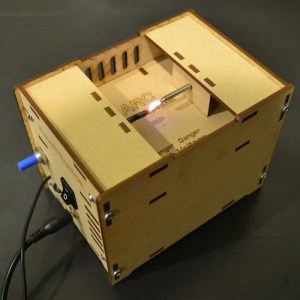How do you listen to your music? Headphones you say? Sometimes on an Airplay or Bluetooth speaker? Oh. That’s pretty cool. I just listen to mine on plasma. Dancing electrical sparks that leap between two electrodes and produce a small amount of ozone. No big deal. Just, you know, how cool people do.
Actually that’s not how I listen to music, but it could be if I back the ARC Plasma Speaker on Kickstarter. The project hasn’t been live for 24 hours, and yet it managed to raise more than its $10,000 goal, and the amount keeps climbing. What it offers clearly appeals to a particular crowd, and that’s probably the group of people who like amazing science projects and DIY physics experiments, which should be everybody.
The ARC takes advantage of a property of an electrical arc, which can “ionize and compress the air around it to play music,” without any drums or vibrations like those you’d get from a standard speaker, which uses electromagnets to produce sound waves. The whole array is housed in a wood case, and the entire build-it-yourself kit is available to backers for only $89. A clear acrylic case that displays the inner workings costs $119, and an assembled version is $225. All kits are expected to ship in July.
If you’re feeling a sense of deja vu, it’s probably because a previous Kickstarter project also promised a plasma speaker kit to backers. That one was funded, but created by a different group, and it was prone to early burn out. The new ARC project is the product of two of the members of the team behind the original, but they’ve refined the design considerably to make sure it can withstand the test of time.
 Seattle-based ExcelPhysics (consisting of Matt Chapman and David Stoyanov) are the brains behind the ARC, and they’ve created other projects including a DIY radiation detector. Their goal is essentially to bring affordable, cool physics projects to market in a way that’s accessible to everyone.
Seattle-based ExcelPhysics (consisting of Matt Chapman and David Stoyanov) are the brains behind the ARC, and they’ve created other projects including a DIY radiation detector. Their goal is essentially to bring affordable, cool physics projects to market in a way that’s accessible to everyone.
As for the ARC, it works with input from basically anything that can output to mini stereo, so your computer, phone or media player should work fine. Plus it’s got a handle, so it’s relatively portable. For general use, a Jambox or something might be more practical, but impressing your physics geek friends while also entertaining them with smooth jams will probably require an ARC.